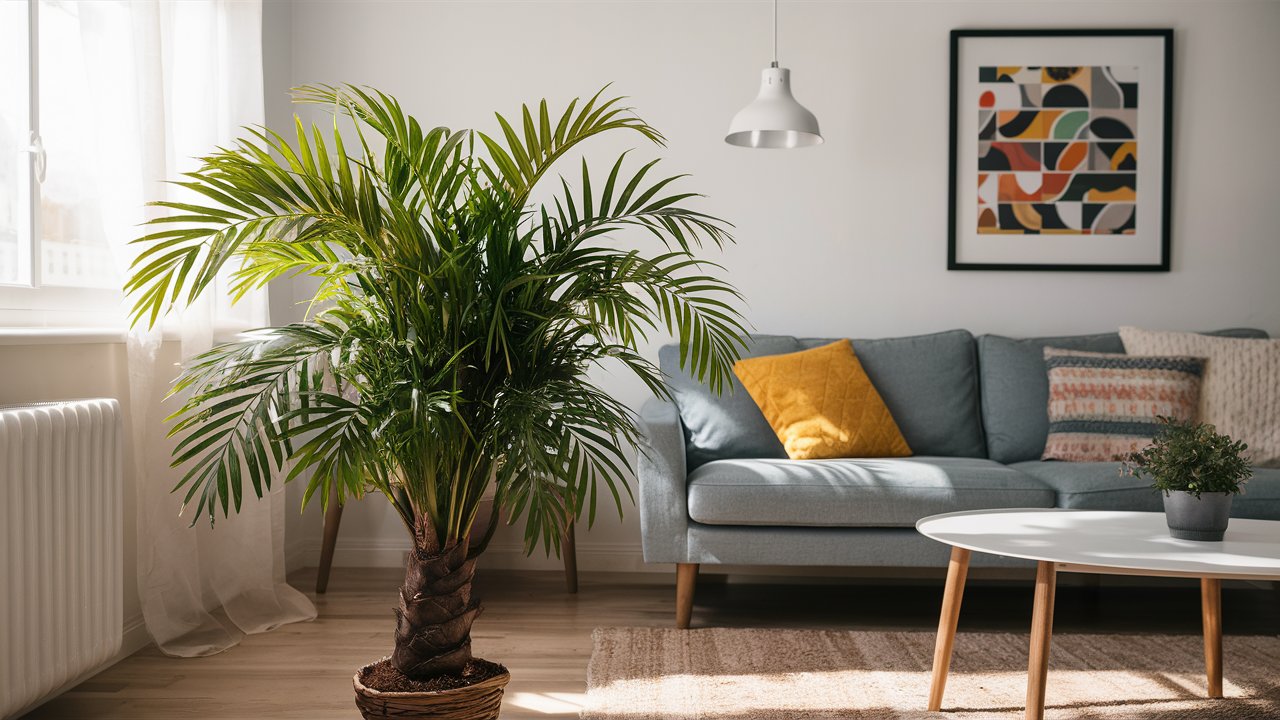Disclosure: Some links on this site are affiliate links. As Amazon Associates, we earn from qualifying purchases (at no cost to you).
The Kentia palm (Howea forsteriana) is a beloved choice among indoor and outdoor plant enthusiasts for its graceful appearance and ease of care.
This elegant palm tree not only adds a touch of tropical charm to any setting but also offers numerous benefits.
Let’s explore the top 10 benefits of Kentia palm trees. (Spoiler alert: They’re more than just a pretty frond!)
10 Benefits Of Kentia Palms (+Decor IDEAS!)
1. Improves Air Quality

Kentia palms are like the superheroes of the plant world. They filter out toxins like formaldehyde, benzene, and carbon monoxide, making your indoor environment healthier.
By removing these pollutants, Kentia palms help improve overall air quality, which can enhance respiratory health and reduce allergy symptoms.
Who knew a plant could be a breath of fresh air?
2. Low Maintenance

One of the standout features of the Kentia palm is its low maintenance nature.
These palms are highly adaptable and can thrive in various light conditions, from low to bright indirect light. They are also drought-tolerant, requiring only occasional watering.
This makes them perfect for busy individuals or those new to plant care. Think of them as the “set it and forget it” of the plant world.
3. Aesthetic Appeal

With their tall, slender trunks and graceful, arching fronds, Kentia palms add a touch of elegance to any space.
Their lush green foliage creates a tropical ambiance, making them a popular choice for interior decorators and landscape designers. Whether placed in a living room, office, or garden, Kentia palms enhance the visual appeal of their surroundings.
It’s like having a piece of paradise at home without the sand in your shoes.
4. Durability and Longevity

Kentia palms are renowned for their durability and longevity. They can live for many years with proper care, making them a long-term investment for your home or garden.
Their slow growth rate means they maintain their shape and size for extended periods, requiring less frequent pruning. It’s the plant that keeps on giving!
5. Versatility

These palms are incredibly versatile and can be used in various settings. They thrive both indoors and outdoors, making them suitable for homes, offices, and gardens.
Kentia palms can adapt to different soil types and light conditions, allowing for flexible placement and design options. They’re the chameleons of the plant world – except they’re not green with envy, they’re just green.
6. Stress Reduction

Plants like the Kentia palm have been shown to reduce stress and promote a sense of well-being. Their presence can create a calming atmosphere, helping to lower stress levels and improve mental health.
The gentle sway of their fronds can be particularly soothing, contributing to a more relaxed environment. It’s like having a spa day every day, minus the cucumbers on your eyes.
7. Humidity Regulation

Kentia palms release moisture into the air through a process called transpiration. This helps to maintain optimal humidity levels, which is beneficial for skin and respiratory health.
By increasing humidity, Kentia palms can prevent dry skin, reduce the risk of respiratory issues, and create a more comfortable living environment. Who knew a palm could be your personal humidifier?
8. Pet-Friendly

Unlike some indoor plants, Kentia palms are non-toxic to pets.
This makes them a safe choice for households with cats, dogs, or other animals. You can enjoy the beauty and benefits of these palms without worrying about the safety of your furry friends.
Finally, a plant that says, “Paws off, but I’m not toxic!”
9. Boosts Productivity

Having plants like Kentia palms in the workspace has been linked to increased productivity and creativity. The presence of greenery can enhance focus, reduce fatigue, and create a more pleasant working environment.
This makes Kentia palms an excellent addition to home offices or study areas. Who knew a plant could be your productivity partner?
10. Natural Decor Element

Kentia palms make excellent natural decor elements. They can fill empty corners, create focal points, and even act as natural dividers in open spaces.
Their elegant fronds add a touch of sophistication and can complement a variety of interior styles, from modern to traditional. And let’s be honest, they look pretty darn cool.
How to Care for Kentia Palms
Caring for Kentia palms is relatively easy, making them a favorite among plant enthusiasts. Here’s a simple guide to keep your Kentia palm healthy and thriving:
Light
Kentia palms thrive in indirect light. They can tolerate low light conditions, but they do best in bright, indirect light. Avoid direct sunlight as it can scorch the leaves.
Watering
Water your Kentia palm when the top inch of soil feels dry. Ensure that the pot has good drainage to prevent root rot. Overwatering can be more detrimental than underwatering, so err on the side of caution.

Soil
Use a well-draining potting mix. A mix designed for palms or a general indoor plant mix with added perlite or sand works well.
Humidity
Kentia palms appreciate high humidity. If your home is dry, especially during winter, consider using a humidifier or placing a tray of water near the plant. Regular misting can also help.
Temperature
Keep your Kentia palm in temperatures between 65-85°F (18-29°C). They do not tolerate cold drafts or sudden temperature changes.
Fertilizing
Feed your Kentia palm with a balanced liquid fertilizer every 2-3 months during the growing season (spring and summer). Reduce feeding during the winter months.
Pruning
Prune only to remove dead or yellowing leaves. This helps keep the plant healthy and attractive. Avoid cutting healthy green fronds as it can stress the plant.

FAQ
Q: How fast do Kentia palms grow?
A: Kentia palms are slow growers, typically growing only a few inches per year. This slow growth makes them manageable as indoor plants.
Q: Can I place my Kentia palm outside?
A: Yes, Kentia palms can be placed outside in shaded or partially shaded areas during the warm months. However, they should be brought indoors before temperatures drop below 50°F (10°C).
Q: What should I do if my Kentia palm leaves are turning brown?
A: Brown leaf tips are often a sign of low humidity or overwatering. Ensure your palm is not sitting in water and increase the humidity around the plant.
Q: How often should I repot my Kentia palm?
A: Kentia palms prefer to be slightly root-bound. Repotting every 2-3 years is usually sufficient. When repotting, choose a pot that is only slightly larger than the current one.
Q: Are Kentia palms safe for pets?
A: Yes, Kentia palms are non-toxic to pets, making them a great choice for households with animals.
Q: Can Kentia palms handle direct sunlight?
A: While they can tolerate some morning sunlight, prolonged exposure to direct sun can scorch their leaves. It’s best to keep them in indirect light.
Final Thoughts
Kentia palms are not only beautiful but also beneficial for your indoor environment. They improve air quality, add aesthetic value, and are relatively easy to care for. With the right light, water, and care, your Kentia palm can thrive for many years, bringing a touch of tropical elegance to your home or garden.


